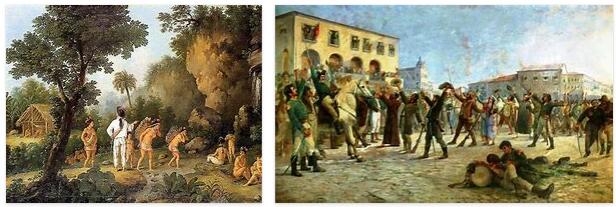The indigenous people
About 30,000 years ago, the first people came to America from Asia via the Bering Strait. They settled the continent from the north. They reached what is now Brazil about 12,000 years ago. However, there are also traces that indicate an even earlier settlement. Different cultures emerged.
Who is Luzia?
In 1975 archaeologists found a woman’s skeleton in a Brazilian cave. The researchers believe that she was one of the first immigrants to South America. Their age is estimated to be 11,000 years. She was called Luzia after Lucy, whose skeleton is 3.2 million years old and is one of the oldest finds ever and which had been found in Africa shortly before.
Who were the Tupi?
From around 8000 BC The Indians settled down in the 4th century BC. Several indigenous peoples emerged. The largest were the Tupi, the Guaraní, the Gê and the Arawak. The Tupi lived on the Atlantic coast. There were many Tupi tribes, but what they had in common was their language, the Tupi language. The Tupi language was used for communication with the white settlers until the 18th century.
Their villages were enclosed by palisades, the houses they built out of wood and covered with palm straw. They grew corn, sweet potatoes, peanuts, beans, and pumpkins. The Tupi are best known for their cannibalism: They were enemies with other tribes and if they killed an enemy, they ate him. They believed that this was how they absorbed his strength and courage.
The Tupi, like the Guaraní and the other peoples of Brazil, were evangelized and enslaved by the European settlers. Many died as a result of diseases that are more harmless to us, such as measles, because they had no immune system for it.
Because the Portuguese settlers were mostly men, they often took Tupi as their wives. Many of today’s Brazilians therefore have Tupi ancestors. But who were the settlers?
The division of the world
As early as 1494, Spain and Portugal had decided to divide South America among themselves. The Tordesillas Treaty stipulated that Portugal was only awarded the east. It gave the entire west of the continent to Spain, but was allowed to retain control over Africa and thus via the sea route to India. Other sea powers such as England did not recognize the treaty. In 1750 the borders were redefined again, which brought more land to Portugal. To this day, the effects of these treaties can be seen in the languages spoken: the east of South America became a Portuguese colony, the west and south were in Spanish hands.
Pedro Álvares Cabral
Pedro Álvares Cabral was a Portuguese navigator. He came to Brazil in 1500 and is considered to be the “discoverer” of the country. Actually India was his destination, but winds drove his fleet far to the west and so Cabral landed roughly in the middle of today’s coastline of Brazil, near today’s city of Porto Seguro. Cabral took possession of the land for the Portuguese crown. Only from here did he go on to India. However, he sent one of his ships back to Portugal to announce the possession there.
Portuguese Colony – Viceroyalty of Brazil
Portuguese traders came to Brazil in the first few years after Cabral took possession. They bartered with the locals. But the French also came and traded mainly in Brazil wood, a type of tree that was suitable for dyeing fabrics. To curb this, the Portuguese king decided to send settlers to Brazil. To get more information on Brazil and South America, check paradisdachat.
Sugar cane plantations were created and the Indians were dragged from the interior to the northeast coast to work there. Because countless Indians died, people began to bring slaves from Africa. Although they were forcibly baptized, they mostly kept their old African religion and so elements of both religions mixed together. Belief in ghosts taking possession of a person was one of them.
Quilombos and Bandeirantes
In 1549 Salvador da Bahia was made the capital of the colony. Other cities were founded. Buildings were built in typical colonial architecture. Escaped black slaves built villages, the Quilombos, in the 17th century.
At the same time, expedition troops explored the unexplored interior. The participants in these expeditions were called Bandeirantes. They looked for gold and diamonds, but also for the escaped slaves or natives who they wanted to enslave. When the Bandeirantes came to new areas, they hoisted the Portuguese flag (bandeira) and also took possession of this land. The Bandeirantes are partly responsible for the size of Brazil today, which after the treaty with Spain was entitled to much less land.
In 1763 Rio de Janeiro became the new capital.
Who was Tiradentes?
The first to fight for Brazil’s independence from Portugal was Tiradentes. His real name was Joaquim José da Silva Xavier. He got his nickname because he earned his living pulling teeth – Tiradentes means “tooth puller”.
In the middle of the 18th century there were fewer gold finds and the taxes to the colonial power were high. A number of settlers opposed this. Tiradentes became their leader. But the conspiracy was uncovered and Tiradentes was executed on April 21, 1792. Tiradentes later became a national hero and the anniversary of his death became a national holiday.
